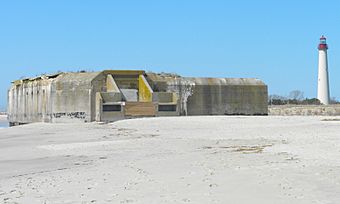Battery 223 facts for kids
|
Battery 223
|
|
 |
|
| Location | Beach at Cape May State Park, Lower Township, New Jersey |
|---|---|
| Area | less than one acre |
| Built | 1942 |
| Architect | U.S. Army Corps of Engineers; White Construction |
| Architectural style | Mid 20th century |
| NRHP reference No. | 08000555 |
Quick facts for kids Significant dates |
|
| Added to NRHP | June 25, 2008 |
Battery 223 is a cool old building in Lower Township, New Jersey, right in Cape May County, New Jersey. It was built a long time ago, in 1943, to help protect the coast during World War II. Today, it's a historic place, added to the National Register of Historic Places in 2008.
Contents
Protecting the Coast: Battery 223's Story
Before the United States joined World War II, people worried that America's coastlines weren't safe enough. So, in 1940, a big plan called the "Modernization of the Coastal Defense program" began. Battery 223 was a part of this plan. Its job was to help protect the coast from enemy attacks.
Building a Stronghold: Fort Miles and Battery 223
Battery 223 was one of three special forts built for Fort Miles. Fort Miles was headquartered in Cape Henlopen, Delaware. These forts were designed to hold powerful 6-inch guns. They were also built to survive direct hits from battleships or airplanes.
The walls of Battery 223 were super thick, about six feet of reinforced concrete. The roof was also very strong to protect against blasts. The entire building was even covered with earth to hide it. The 6-inch guns it held could shoot up to nine miles away!
Fort Miles had even bigger guns at Cape Henlopen. There were 16-inch guns that could shoot 26 miles! Fort Miles protected about 200 miles of coastline. It even had a network of 20 tall towers to help spot enemies.
From War to Park: Battery 223's Later Years
Even though it was built for war, Battery 223's guns were never fired at an enemy. They did practice drills and tests, though. As the war started to go well for the Allies, coastal defenses became less important. Also, new war technology made these big, fixed forts less useful.
Battery 223 was officially taken out of service in 1944. By 1948, all the Army's big coastal defense guns were gone. The buildings were then used for other military purposes or sold off.
After 1958, the Navy used Battery 223 for radio communications. They even poured a concrete pad on top for a Quonset hut (a type of lightweight building). In 1962, Battery 223 became part of the Cape May Point State Park. Today, the battery is no longer covered by earth. You can see it clearly!
Inside Battery 223: Its Design
Battery 223 looks like a series of concrete blocks without windows. It's shaped a bit like the letter "T". The long part runs along the beach, and the "stem" of the "T" points north.
Rooms and Their Jobs
Inside, there are 20 rooms. These include a "plotting room" and a "switchboard room." There were also rooms for storing shells and a special room for chemical warfare supplies. An "airlock" helped protect against chemical attacks.
The building sits on wooden pilings. These were once buried in the sand, but now you can see them because of beach erosion.
Power and Communication
Three diesel generators provided power for the battery. They had big exhaust pipes and mufflers. There were also special "evaporative water coolers" in another room.
The switchboard room was important for connecting the plotting room to the outside towers. The plotting room received information from two towers. This information helped them figure out where an enemy target was. Then, they could tell the gunners exactly where to aim.


